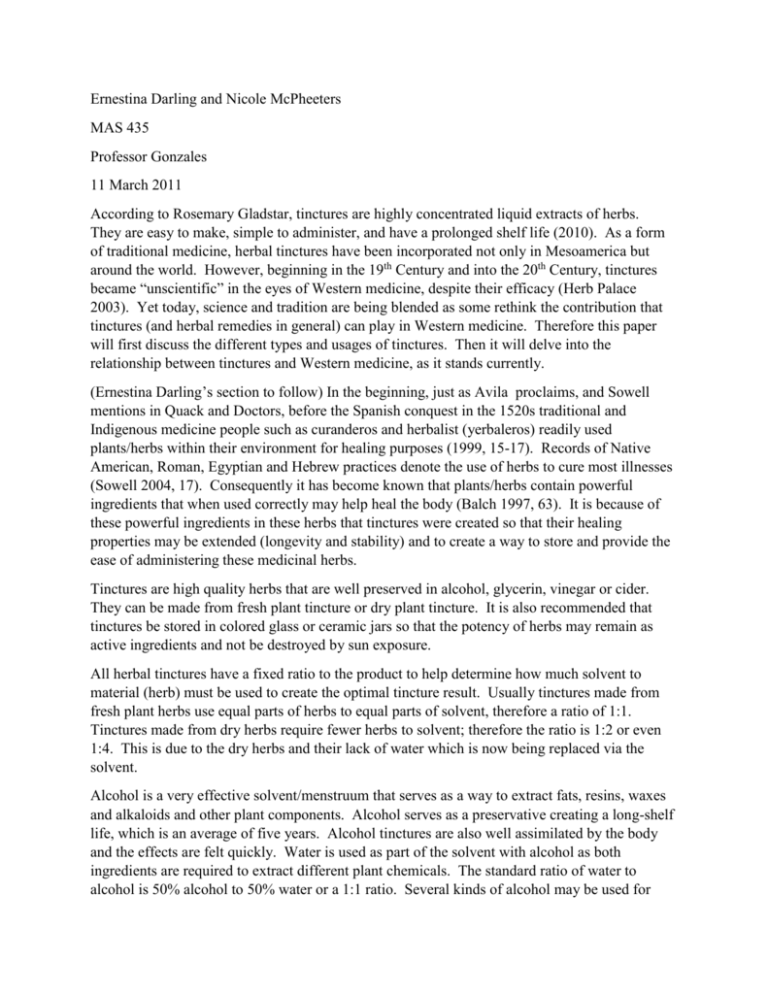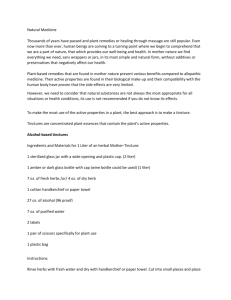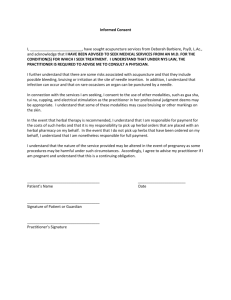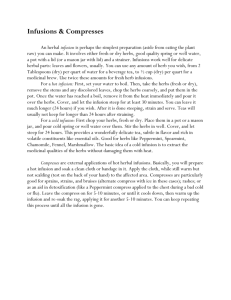Document 6762101
advertisement

Ernestina Darling and Nicole McPheeters MAS 435 Professor Gonzales 11 March 2011 According to Rosemary Gladstar, tinctures are highly concentrated liquid extracts of herbs. They are easy to make, simple to administer, and have a prolonged shelf life (2010). As a form of traditional medicine, herbal tinctures have been incorporated not only in Mesoamerica but around the world. However, beginning in the 19th Century and into the 20th Century, tinctures became “unscientific” in the eyes of Western medicine, despite their efficacy (Herb Palace 2003). Yet today, science and tradition are being blended as some rethink the contribution that tinctures (and herbal remedies in general) can play in Western medicine. Therefore this paper will first discuss the different types and usages of tinctures. Then it will delve into the relationship between tinctures and Western medicine, as it stands currently. (Ernestina Darling’s section to follow) In the beginning, just as Avila proclaims, and Sowell mentions in Quack and Doctors, before the Spanish conquest in the 1520s traditional and Indigenous medicine people such as curanderos and herbalist (yerbaleros) readily used plants/herbs within their environment for healing purposes (1999, 15-17). Records of Native American, Roman, Egyptian and Hebrew practices denote the use of herbs to cure most illnesses (Sowell 2004, 17). Consequently it has become known that plants/herbs contain powerful ingredients that when used correctly may help heal the body (Balch 1997, 63). It is because of these powerful ingredients in these herbs that tinctures were created so that their healing properties may be extended (longevity and stability) and to create a way to store and provide the ease of administering these medicinal herbs. Tinctures are high quality herbs that are well preserved in alcohol, glycerin, vinegar or cider. They can be made from fresh plant tincture or dry plant tincture. It is also recommended that tinctures be stored in colored glass or ceramic jars so that the potency of herbs may remain as active ingredients and not be destroyed by sun exposure. All herbal tinctures have a fixed ratio to the product to help determine how much solvent to material (herb) must be used to create the optimal tincture result. Usually tinctures made from fresh plant herbs use equal parts of herbs to equal parts of solvent, therefore a ratio of 1:1. Tinctures made from dry herbs require fewer herbs to solvent; therefore the ratio is 1:2 or even 1:4. This is due to the dry herbs and their lack of water which is now being replaced via the solvent. Alcohol is a very effective solvent/menstruum that serves as a way to extract fats, resins, waxes and alkaloids and other plant components. Alcohol serves as a preservative creating a long-shelf life, which is an average of five years. Alcohol tinctures are also well assimilated by the body and the effects are felt quickly. Water is used as part of the solvent with alcohol as both ingredients are required to extract different plant chemicals. The standard ratio of water to alcohol is 50% alcohol to 50% water or a 1:1 ratio. Several kinds of alcohol may be used for tincture making including Vodka, Gin and Brandy, as these can be purchased as 100 proof. However; for good extraction and preservative purposes a minimum of 25% alcohol by volume is required. When looking for strong medicinal purpose, the alcohol based tinctures are more effective and they are extremely potent and quickly assimilated in the body (Gladstar 2010). So for excellent tincture quality, don’t scrimp on quality and buy the best alcohol you can afford. Glycerin is a sweet and nutritious substance which contains oils and fats of both animal and plant origin. It is also very soothing to the mucus membrane lining in our system. It is because of this that glycerin is a great solvent for tinctures for children, alcoholics, or people who do not care for the use of alcohol. Although it is a great preservative, and dissolves vitamins, minerals, and mucilage, it does not do as well at dissolving oily or resinous components as alcohol does (Gladstar 2010). When buying glycerin at a Natural Food store, make sure it is 100% vegetable glycerin as this is a better quality glycerin. Since vinegar is not as strong as alcohol, it will not break down all of the herbal/plant components as well as alcohol. However; vinegar has some excellent qualities as a tincture solvent. An organic-apple cider vinegar would be the best choice and since it is a food source, it is 100% non-toxic and tastes good as well. It is usually well tolerated by everyone and can help regulate the acid/alkaline balance in the body and even serve as an excellent tonic for the digestive tract. You can add a little honey and make it taste even better (Gladstar 2010). So, apple cider vinegar is a good solvent/menstruum for children, alcoholics or people who do not care for the use of alcohol. Apple cider vinegar as a menstruum in a tasty, sweet manner will make the herbal tincture more like food than a medicine. Therefore glycerin or apple cider vinegar would be the best choices to create herbal medicinal tinctures for children. The shelflife of vinegar tinctures has been very controversial with statements claiming they are only good for a period of six months before deteriorating. Rosemary Gladstar, however, states that her personal experience as well as her peers, has shown vinegar tinctures will last for several years when stored in a cool, dark place (2010). Tinctures offer the best way to extract and deliver nutrients from herbs/plants in a soluble form, optimal for absorption and assimilation into the body. They retain the key ingredients essential for healing which are normally lost in heat treated or reprocessed dry extracts. Herbs are just as effective as drugs and should be used cautiously and with respect, knowing that herbs, as living organisms can create healing. Tinctures are to be used in one half cup of water, after measuring one teaspoon or five to ten drops to be mixed, depending on the herb. Some herbs, such as gobernadora or creosote, are extremely potent and can be dangerous. Some of the most common herbs and their uses are: Aloe Vera has astringent, emollient, antifungal, antibacterial and antiviral qualities Reduces blood glucose levels – diabetes Reduces cholesterol levels (Kane 2009, 55) Creosote helps ease pain, helps with rheumatoid arthritis, asthma, Reduces bronchial airway stuffiness, antioxidant, Helps immune system, good for colds, sinus, allergies, flu, etc. Antimicrobial, antifungal (Kane 2009, 102) Yucca Rheumatoid arthritis – pain Chronic pain, helps decrease cholesterol levels (Kane 2009, 275) Sage helps with fever, dry moderate temperature, Fights infection, useful for coughs Gas, spasms, memory loss and poor cognition (Kane 2009, 222) Lemon Balm Is a sedative and mild antispasmodic, anxiety reducer, Helps with depression and general exhaustion, Stomach distress and stomach cramps (Gladstar 2010) Peppermint refreshing – pure green energy (Gladstar 2010) Yerba Buena potent digestive aid, helps upset stomach Circulatory stimulant, suitable for children (Gladstar 2010) Comfrey Provides a soothing healing effect on all organs Good source of calcium, vitamins B, C, E, iron, Manganese, phosphorous and pantothenic acid (Gladstar 2010) (Nicole McPheeters’ section to follow) While tinctures have been important in traditional medicine for thousands of years, there has been a serious lack of incorporation by Western science and medicine of this ancient remedial concept. However, this was not always the case. Up until and even into the 19th Century, American doctors relied on herbal remedies to treat their patients. The Pharmacopeia was first published in the United States in 1820, which included a listing of many herbal drugs with their properties, dosage, usage, and purity. After being revised several times, it became the legal standard for medical compounds in 1906 (Herb Palace 2003). Yet as the 19th Century advanced, Western medicine became more scientific. Eventually the pharmaceutical companies replaced herbalists, due to their ability to extract and synthesize plant extracts (Herb Palace 2003). Traditional herbal remedies, which before had always been so important in medicine, were now considered unscientific, and therefore marginalized. The thought process would be cyclical, though, because starting in the 1960’s with the hippie, alternative movement and the civil rights movement of many Indigenous people, herbal remedies came back into fashion (at least in certain groups; although many Indigenous and/or Mexican healers never abandoned the practice). Today, parts of Western medicine are taking a scientific approach to try to verify the beneficial properties of herbal remedies, including tinctures. This section will look at particular Western experiments on tinctures, and how they evaluated them, plus what this implies for Western medicine’s attitude towards traditional tinctures. The first tincture experiment was conducted in Aurel Vlaicu University in Arad, Romania. Selecting eleven spices, the researchers tinctured them to determine their antioxidant and antimicrobial properties or basically their antiradical properties (Szabo et al 2010, 535). The eleven spices are: basil, celery, dill, horsetail, lovage, marjoram, milfoil, oregano, parsley, rosemary, and thyme. Through the medium of DPPH (1, 1-diphenyl-2-picrylhydrazyl), the antioxidant effects of the spices were tested on vegetable and animal fats using an oxidation test, while the antimicrobial properties were tested (according to the Kirby-Bauer test) on bacterial strains in agar disks (Szabo et al 2010, 538). The study was done for two years, with the result that milfoil, rosemary, and marjoram had the most antiradical properties, especially when freshly tinctured. However, dill, celery, horsetail, and parsley had low antiradical properties (Szabo et al 2010, 540). They then made a mixed tincture out of milfoil, rosemary, marjoram, thyme, lovage, oregano, and basil, that created a highly antiradical and aromatic tincture. The purpose of the experiment was to find a natural substitute to synthetic food additives, some of which are suspected to be toxic, and according to their findings the tincture above can be used to replace the synthetic antioxidants. A second study felt that the areas of curanderismo and alternative medicine have been disregarded by Western science and medicine. Therefore the researchers decided to look at 23 plants from the South of Texas, which were known for treating wounds and infections, to determine their antibiotic properties. To do this, they prepared ethanolic and aqueous tinctures and applied them, by means of the Kirby-Bauer test, to three common strains of bacteria in diffusion disks (Romero et al 2005, 254). These were then compared to the pharmaceutical antibiotic diffusion disks, with control disks containing solvent. Ten of the 23 herbs were found to be antibiotic towards the bacteria strain, Staphylococcus aureus, but did not consistently inhibit growth to the other two strains (Romero et al 2005, 257). From this, the researchers wish for continued study of traditional herbs and remedies, plus the realization that curanderismo can be a legitimate form of medicine. A last example of a case-study worked with tinctures and mother tinctures, looking specifically at their content and stability. They experimented with the flowers and leaves of Hawthorn and with Hawkweed. At the beginning of the paper, the researchers state that they already know Hawthorn to be good for cardiac diseases, while Hawkweed is beneficial for cellulitis and obesity because of its diuretic properties (Bilia et al 2006, 70). So instead of looking for the valuable qualities of the two herbs, they based their research on the qualitative and quantitative marker constituents (like a flavonoid) of the herbs and those constituents stability over time. They did this by looking at two different methods for making the tinctures and mother tinctures. In qualitative analyses, the tinctures and mother tinctures were similar, while in quantitative data they varied (Bilia et al 2006, 77). The most noted differences came in the quantitative profile and the stability of the constituents. Yet it was proven that both preparations of the tinctures and mother tinctures of Hawthorn and Hawkweed are viable herbal drugs, because they are easy and affordable for the public, but are not necessarily interchangeable. These examples of experimental studies done by scientists demonstrate a shift in ideology in Western medicine. No longer are traditional remedies, including tinctures, relegated to the category of unscientific, based on magic, or unconventional. True, pharmaceutical, synthetic drugs still make up most of medical prescriptions in Western medicine, but the fact that so many analyses are being conducted on herbal tinctures, remedies, etc, lend itself to the idea that Westerners are looking for other sources for their ailments. There is good reason for this too; as shown in the first study, some food additives are potentially toxic. Returning to the fore of medicine, which they have occupied for thousands of years previously, herbal tinctures (as a branch of herbal remedies) are now being considered by the Western public, scientists and doctors alike, as Dr. Low Dog (M.D.) exemplifies with her statement, “Science reveals that many common herbs and spices used to enhance the flavor of food contain powerful components that have the ability to enhance human health,” (2009, 101). Here science and tradition blend and create harmony between the two. Hopefully Western medicine will waste no more time in utilizing the vast stores of knowledge that can be gained from traditional tinctures and remedies. In conclusion, tinctures are a viable form of medicine, not only in traditional cultures but now, once again, in Western medicine. The different types (alcohol, glycerin, and vinegar), the variety of plants and herbs that can be used, and the simplicity of preparation, afford the public the ability to make and store tinctures on their own. That is one of the most important benefits of tinctures, their easy availability, along with all the health advantages from the herbs or plants themselves, which Western medicine, finally, is realizing and the native peoples have known all along. Works Cited Avila, Elena and Joy Parker. Woman Who Glows in the Dark. (New York: Penguin Putnam, 1999), 15-17. Balch, James. Prescription for Nutritional Healing. (New York: Avery Publishing, 1997), 63-4. Bilia, Anna Rita, and Federico Eterno, Maria Camilla Bergonzi, Giovanni Mazzi, Franco Francesco Vincieri. “Evaluation of the Content and Stability of the Constituents of Mother Tinctures and Tinctures: The Case of Crataegus oxyacantha L. and Hieracium pilosella L.” Journal of Pharmaceutical and Biomedical Analysis 44 (2007): 70-78. Accessed March 1, 2010. doi: 10.1016/j.pba.2007.01.046. Gladstar, Rosemary. “Advantages of Herbal Tinctures.” Sage Mountain Retreat. Last modified 2010. http://www.sagemt.com. Herb Palace. “History of Herbal Medicine.” Last modified 2003. http://www.herbpalace.com/alternative-medicine/herbal-medicine.html. Kane, Charles W. Herbal Medicine of the American Southwest: The Definitive Guide: Medicinal And Edible Plants/ Collection, Preparation, Use, and Caution. (US: Lincoln Town Press, 2009), 1-50. Low Dog, Tieraona. “Smart Talk on Supplements and Botanicals: Herbal Teas Versus Tinctures; Standardized Extracts; Green Tea.” Alternative and complementary therapies 15 (2009): 101-03. Accessed March 1, 2010. doi: 10.1089. Romero, Christopher David, and Suzzette Fontenelle Chopin, Gregory Buck, Elvia Martinez, Michelle Garcia and Lisa Bixby. “Antibacterial Properties of Common Herbal Remedies of the Southwest.” Journal of Ethnopharmacology 99 (2005): 253-57. Accessed March 1, 2010. doi: 10.1016/j.jep.2005.02.028. Sowell, David. “Quacks and Doctors: The Construction of Biomedical Authority in Mexico.” (Huntington: Juniata College Press, 2005), 17. Szabo, M.R, and D. Radu, S. Gravilas, D. Chambre, C. Iditoiu. “Antioxidant and Antimicrobial Properties of Selected Spice Extracts.” International Journal of Food Properties 13 (2010): 535-45. Accessed March 1, 2010. doi: 10.1080/10942910802713149.



